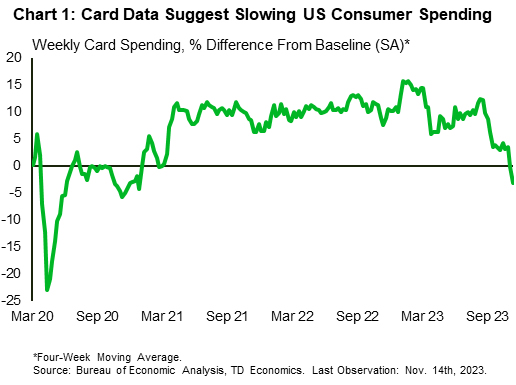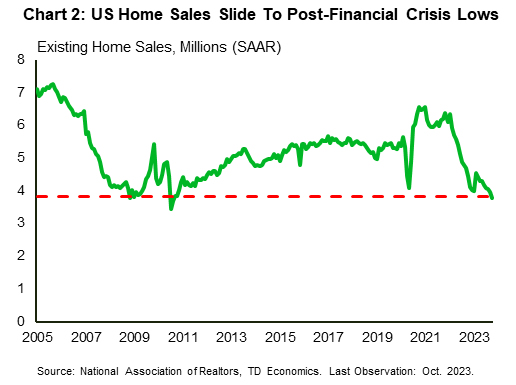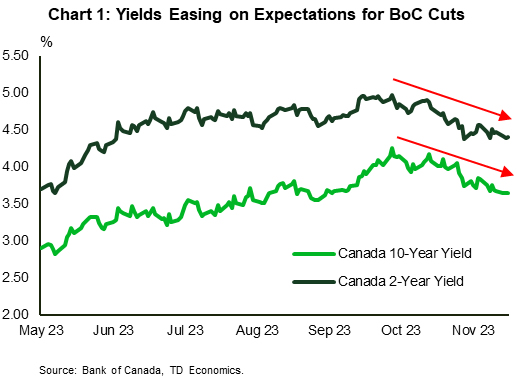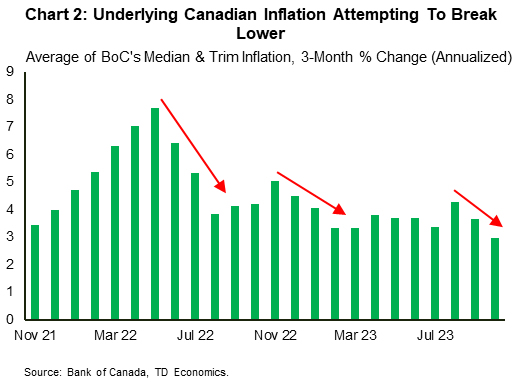U.S. Highlights
- Minutes from the Federal Open Market Committee (FOMC) meeting reinforced the Fed’s messaging that patience is warranted while the disinflation process is working.
- Existing home sales sag as high prices and financing costs make homes their least affordable since the mid-80s.
- All eyes will be on next week’s personal income and spending report for October, watching for further signs of slowing demand growth.
Canadian Highlights
- Events this week reinforced our view that the Bank of Canada won’t be hiking rates again.
- Inflation decelerated significantly in October, thanks both to energy prices and some welcome softening in core inflation measures.
- The Federal government also released its Fall Economic Statement, which showed that the government won’t be adding any additional inflation stimulus relative to what it was already contributing.
U.S. – Looking for Signs of Slowing
U.S. Treasury yields extended their decline this week, with the 10-year now hovering around 4.5%. As economic data have decelerated, expectations for policy easing next year have helped markets continue to rally – up about 1% this week. This week, minutes from the Federal Open Market Committee (FOMC) meeting reinforced the Fed’s messaging that patience is warranted while the disinflation process is working, while housing starts data showcased that higher interest rates are working to cool the economy. Coming off the Thanksgiving holiday, all eyes are now tuned to next week’s consumer spending report for October for signs of slowing economic momentum and cooling inflation.
The minutes from the FOMC’s last meeting essentially backed up the hawkish signals the Fed has been putting out while they hold the policy rate fixed. Committee members noted how the economy stayed unexpectedly hot through the third quarter of the year, powered by relentless consumer spending. With the supply shocks from the pandemic and the war in Ukraine still gradually resolving themselves, persistently strong aggregate demand helped keep pressure on prices through much of the year. However, committee members judged that this may be starting to shift (Chart 1). This has left the Fed squarely focused on cooling demand to tame inflation pressures. On this front, the Fed maintains that restrictive policy rates are working, and are at an appropriate level. Moreover, with members agreeing that there needs to be clear evidence that inflation is on a solid trajectory back to 2% before easing, and upside risks ever-present, officials will be keenly looking out for any signs that more needs to be done to restore the supply-demand balance.
On the demand side, the housing market is clearly responding to the surge in borrowing costs since the summer, with existing home sales in October falling to their lowest level since 2010 (Chart 2). However, conditions today are drastically different than in 2010, when the housing bubble burst leading to an abundance of supply, and a tepid recovery after the Global Financial Crisis saw a drastic improvement in affordability. Today, affordability is weighing on activity as high prices and financing costs make homes their least affordable since the mid-80s. With the Fed poised to keep rates at multi-decade highs, a quick turnaround is unlikely.
However, with healthy economic momentum through the third quarter all eyes will be on next week’s consumer income and spending report for signs of slowing demand growth. With payrolls growth slowing in October, consensus expectations are for real consumer spending growth to slow from 0.4% month-on-month (m/m) in September to 0.1% in October. The Fed’s preferred inflation measure, the core PCE deflator, is expected to follow suit, slowing to 0.2% m/m from 0.4% in September.
Of course, given the experience of the past year, the risks run to the upside, and that the American consumer will once again prove to be more resilient than expected. In that event, the Fed has told us it stands ready to tighten policy further if they assess that data show, “progress toward the Committee’s inflation objective was insufficient.”
Canada – No More Hikes!
Events this week reinforced our view that the Bank of Canada (BoC) won’t be hiking rates again. Inflation showed a big deceleration in October, causing BoC Governor Macklem to give one of his more dovish speeches. The Federal government also delivered a slimmed down forecast for deficit spending than expected over the next year. Core retail sales also showed weakness. Overall money markets continue to think the next move for the BoC is going to be a cut in the spring of 2024, leaving the Canada 10-year yield at around 3.8%, much lower than its September peak of 4.3% (Chart 1).
The much-anticipated release of Canadian inflation came in as we expected, with the Consumer Price Index (CPI) posting a 3.1% year-on-year (y/y) increase. This was a marked improvement from the 3.8% y/y rate of price growth in September. Welcome news of course, but nearly all of this was due to the drop in gasoline prices over the last year.
The question is: Will the deceleration in inflation continue? To answer that we must look at the trend in core inflation. This strips out the volatility in food and energy prices. And the good news is that the BoC’s core measures broke lower in October on a three-month annualized basis (Chart 2). The average of the BoC’s measures had been stuck around the mid-3% level for all of 2023, but as of October this measure now sits at exactly 3.0%. It’s not 2% like the BoC would prefer, but it has moved lower. Weaker goods inflation drove the deceleration, as retailers appear to be discounting heavily. Just in time for the holiday shopping season! While we expect this trend to continue, we do not see the same downward trend when it comes to services inflation. Our measure of supercore services inflation that strips out things like housing costs and travel has been running north of 4% for two years now. This is largely driven by wages, which no surprise, are running hot at 5%.
The Federal government’s Fall Economic Statement (FES) is also closely monitored by the BoC. Prior to the release, government spending was forecast to grow well above trend economic growth next year. This has drawn some soft criticism from the BoC Governor, who has stated that the Feds are rowing in the opposite direction as the BoC when it comes to wrestling inflation back to target. And while the FES has budgeted for new spending to increase housing supply, the bulk of spending will occur two years from now, containing spending growth in the near term. This means that government spending won’t be increasing inflationary pressures in the near-term any more than it already was, but spending will start to ramp up in 2025. Let’s hope inflation will be reined in by that point!
Governor Macklem’s speech in Saint John following the release of CPI and the FES exuded more confidence regarding the outlook, stating that “interest rates may now be restrictive enough to get us back to price stability”. The Governor was clearly encouraged by recent events, and his dovish tone has reinforced bets that the next move by the BoC is going to be a cut to its policy rate.

















